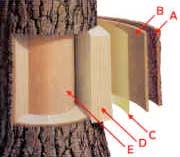Did you know that trees communicate? Yes, you heard right – trees actually communicate with one another through their root systems. This communication is integral to your trees’ health, growth, and longevity. So how does it work, and how can you protect this communication system to ensure that your trees have a long and healthy life? Read More
Anatomy of a Tree
 The Inside Story
The Inside Story
- The outer bark is the tree’s protection from the outside world. Continually renewed from within, it helps keep out moisture in the rain, and prevents the tree from losing moisture when the air is dry. It insulates against cold and heat and wards off insect enemies.
- The inner bark, or “phloem”, is pipeline through which food is passed to the rest of the tree. It lives for only a short time, then dies and turns to cork to become part of the protective outer bark.
- The cambium cell layer is the growing part of the trunk. It annually produces new bark and new wood in response to hormones that pass down through the phloem with food from the leaves. These hormones, called “auxins”, stimulate growth in cells. Auxins are produced by leaf buds at the ends of branches as soon as they start growing in spring.
- Sapwood is the tree’s pipeline for water moving up to the leaves. Sapwood is new wood. As newer rings of sapwood are laid down, inner cells lose their vitality and turn to heartwood.
- Heartwood is the central, supporting pillar of the tree. Although dead, it will not decay or lose strength while the outer layers are intact. A composite of hollow, needlelike cellulose fibers bound together by a chemical glue called lignin, it is in many ways as strong as steel. A piece 12″ long and 1″ by 2″ in cross section set vertically can support a weight of twenty tons!
Coast Redwood – Tallest Tree on Record
California’s magnificent Coast Redwood is the world’s tallest known tree and one of the world’s oldest trees. Average mature trees, several hundred years old, stand from 200 to 240 feet tall and have diameters of 10 to 15 feet, and some trees have been measured at more than 360 feet. The tallest tree in the world, The Stratosphere Giant located at Humboldt Redwoods State Park, is just over 370 feet tall. In the most favorable parts of their range, Coast Redwoods can live more than two thousand years. Read More
Benefits of Trees
Public Health and Social Benefits
Air Cleaning: Trees produce oxygen, intercept airborne particulates, and reduce smog, enhancing a community’s respiratory health. The urban canopy directly contributes to meeting a city’s regulatory clean air requirements. Read More



